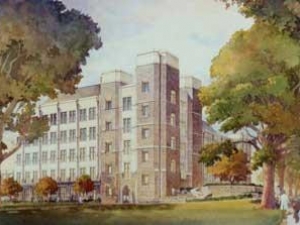The Genome Science Research Building 2 (GSRB2; pictured at right) is home to to 3 core faculty (Meck, Williams & Yin). The third floor (21,444 gross sq. ft.) is a state-of-the-art facility for the study of brain and behavior using small animals as subjects. Experimental rooms for behavioral analysis are equipped with radial-arm and water and Barnes' mazes, activity boxes, startle, and operant conditioning chambers for study of cognitive processes in small rodents. All behavioral test areas are soundproofed and are across the hall from animal housing. There are video-tracking systems in several of the procedure rooms that allow continuous recording in both light and dark phases of the day; computer programs allow for automated collection and analysis of maze and operant data. Home cage wheel running and general activity can be monitored remotely. Wet labs for analysis of RNA, DNA, and immediate early genes, as well as fully equipped histology suite, and several electrophysiology rigs are also available.
Laboratory space: includes desktop computers for each graduate student and offices for postdoctoral fellows. Communal labs available to faculty and Trainees include:
Surgical suite: designed for small animal surgeries and perfusions. It includes a biosafety hood, chemical hood with sink, 2 surgical stations for use with injectable or gas anesthesia, and an anti-room with refrigerator, ice machine, sink and counters for preparing animals for surgery.
Histology: houses standard hooded sink and a vented work station, as well as a radioisotope hood for assays, fully equipped with standard stirrers, shakers, balances, vibratome, microtome, cryostat.
Image analysis: Features 2 Nikon microscopes with video image analysis capability as well as stereology software (Stereologer, Microbrightfield, Inc.) attached to a motorized stage and high resolution video camera. An Olympus epifluorescence microscope is also available.
Electrophysiology suites: equipped with a Plexon recording system for sleep analysis, single or ensemble recording studies,
Molecular biology suite: used for analysis of RNA, DNA (both PCR and fluorescence in situ).
Thirteen animal housing rooms provide ample caging for mice, rats, pigeons and fish for all researchers. All caging (Allentown) is individually ventilated and both bottle water and automatic watering systems are available. A cage wash facility, storage for food and bedding, and general equipment are shared by all researchers on the floor.
The main offices of the Department of Psychology and Neuroscience are located on West campus in one of the original Duke University buildings, The building contains the chair and staff offices, as well as the laboratories for many P&N faculty. The department also has facilities and resources for cognitive neuroscience research in the Center for Cognitive Neuroscience (housed in the Levine Science Research Center-LSRC) and in the Brain Imaging and Analysis Center (BIAC), housed in the Medical Center. Facilities and laboratories for our Systems and Integrative Neuroscience faculty are located in the Genome Sciences Research Building II (GSRBII) located on Research Drive.
The Center for Cognitive Neuroscience houses the office and laboratory of Dr. Groh along with other researchers in the Center. Dr. Groh's behavioral and electrophysiology testing suite for monkeys is located in the University Vivarium which is a building connected to GSRB-II. Faculty at the CCN do their imaging work in the associated Brain Imaging and Analysis Center.
Other Research Facilities relevant to SINS Faculty and Students
Duke Institute for Brain Sciences (DIBS) - A Duke Institute that seeks to seed innovation and collaboration in the Brain Sciences that transcends the boundaries of traditional disciplines and integrates brain sciences with the biomedical sciences, social sciences, life sciences, physical sciences, humanities, law, business, mathematics, computer sciences, and engineering.
Department of Neurobiology is located entirely within the Joseph and Kathleen Bryan Research Building, occupying approximately 32,000 sq. ft. of laboratory, office and administrative space. It is a one-minute walk from CCN, BIAC, GSRBII. The Department has fully equipped laboratories for work ranging from visual psychophysics to single neuron recording in awake, behaving monkeys, to molecular analysis of synaptic function.
Department of Psychiatry and Behavioral Sciences is actively involved in three major areas of research: 1) the understanding of the biological, social and behavioral mechanisms of psychiatric disorders 2) the role of behavior and the central nervous system in somatic disease, 3) clinical trials aimed at the design and implementation of new Major topics currently being addressed by Departmental investigators include mood disorders, schizophrenia, anxiety disorders, attention-deficit disorders, memory disorders, cardiovascular disease, diabetes mellitus and obesity.
Duke Center for Genomic and Computational Biology is Duke University's response to the array oof advances in the Genome Sciences over the last decade. It offers, via it's many centers, a comprehensive approach to the study of life. The Institute, via its training programs, talk series, and integrative outreach brings together scientists, engineers, physicians, lawyers, policy makers, business leaders, economists, ethicists, and humanists to explore the genome.Genome Sciences over the last decade. It offers, via it's many centers, a comprehensive approach to the study of life. The Institute, via its training programs, talk series, and integrative outreach brings together scientists, engineers, physicians, lawyers, policy makers, business leaders, economists, ethicists, and humanists to explore the genome.

